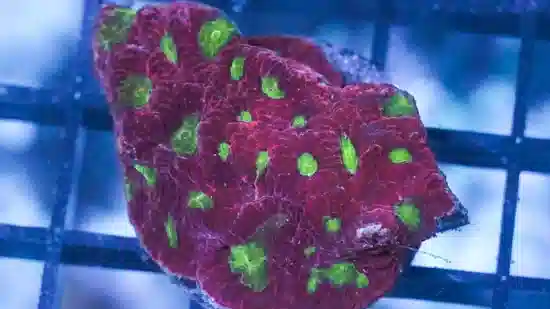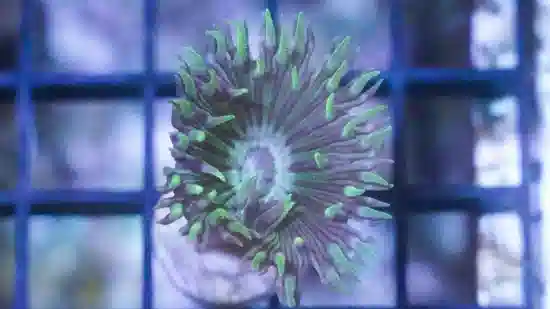Expert Only
Radiant Wrasse - Red Sea
Halichoeres iridis
(2 Reviews)

Expert Only
Radiant Wrasse - Red Sea
Halichoeres iridis
(2 Reviews)
{{ item.name }}
Size: {{ item.extra_field_3 }}
${{ getFormattedPrice(item.saleprice) }} ${{ getFormattedPrice(item.price) }}
To join the waiting list, click here
Free Shipping
With
$199.00
or more in Marine Life.
More details...
Radiant Wrasse - Red Sea Care Facts
| Care Level: | Expert |
|---|---|
| Temperament: | Peaceful |
| Diet: | Carnivore |
| Origin: | Africa/Red Sea |
| Reef Safe: | Yes |
| Minimum Tank Size: | 50 gallons |
| Max Size: | 5 inches |
The Radiant Wrasse (Halichoeres iridis), also known as the Iridis Wrasse, can be found among the reefs of Africa and the Red Sea. They have a vibrant yellow head, with green stripes, that fades into a maroon body. They reach a maximum size of 5 inches and do well in reef aquariums, though their diet consists of crustaceans, so they should not be kept with small, prized invertebrates. They are peaceful towards tankmates, though they may show aggression towards others of their own species; due to this, they are best kept singly or in bonded pairs. They should be offered a variety of crustaceans or vitamin-enriched carnivorous preparations multiple times a day. Plenty of live rock and substrate should be available, as they hide among rocks or bury themselves during the night.
Radiant Wrasse: Adding Vibrancy to Your Marine Aquarium
The Radiant Wrasse (Halichoeres iridis) is a captivating addition to saltwater marine aquariums, renowned for its vibrant coloration and active demeanor. Originating from the Indo-Pacific region, Radiant Wrasses commonly inhabit tropical coral reefs, lagoons, and rocky shores, adding visual appeal to any aquatic setup.
Habitat of Radiant Wrasse
Radiant Wrasses prefer areas with ample hiding spots among rocks and corals and sandy substrate for foraging, mimicking their natural habitat in tropical coral reefs, lagoons, and rocky shores.
Reef Compatibility of Radiant Wrasse
The Radiant Wrasse is generally considered reef-safe, displaying peaceful behavior towards corals and other invertebrates. However, caution should be exercised with smaller crustaceans, such as shrimp, as they may be perceived as prey.
Size and Lifespan of Radiant Wrasse
Typically reaching a maximum size of around 4 to 5 inches (10 to 12 centimeters) in length, Radiant Wrasses can live for up to 5 to 7 years in captivity with proper care.
Diet in Captivity for Radiant Wrasse
Radiant Wrasses readily accept a varied diet of high-quality frozen or live foods such as brine shrimp, mysis shrimp, and chopped seafood. Supplementing their diet with marine flake or pellet food is advisable to ensure balanced nutrition.
Aquaculture and Availability of Radiant Wrasse
While aquacultured specimens of Radiant Wrasses are becoming more available, they are still primarily sourced from wild populations. However, reputable suppliers like Saltwaterfish.com prioritize sustainable practices and may offer aquacultured individuals when possible.
Compatibility of Radiant Wrasse
Radiant Wrasses generally exhibit peaceful behavior towards other fish species, making them suitable tank mates for marine aquarium setups. Compatible tank mates include Flame Angelfish, Royal Gramma, Clownfish, Banggai Cardinalfish, and Firefish Goby.
Sexual Dimorphism in Radiant Wrasse
Male and female Radiant Wrasses exhibit subtle differences in coloration and size, with males typically displaying more vibrant hues and slightly larger than females.
Juvenile to Adult Coloration Changes in Radiant Wrasse
Juvenile Radiant Wrasses boast striking coloration characterized by vibrant blue and yellow stripes along their body. As they mature, their coloration intensifies, with iridescent blue and yellow markings complemented by a stunning orange-red tail.
Temperament of Radiant Wrasse
Known for their lively and active nature, Radiant Wrasses are constantly on the move, darting in and out of hiding spots within the aquarium. Despite their energetic behavior, they are generally peaceful towards tank mates and can be kept in community setups with appropriate companions.
Tank Requirements for Radiant Wrasse
To accommodate the needs of Radiant Wrasses, a minimum aquarium size of 50 gallons is recommended, with a well-established tank featuring ample live rock for hiding and exploration. Water parameters should be maintained with a pH of 8.1 to 8.4, salinity between 1.023 and 1.025, and water temperature ranging from 72°F to 78°F.
Why Choose Saltwaterfish.com for Radiant Wrasse
Saltwaterfish.com is committed to providing hobbyists with premium-quality marine livestock, including Radiant Wrasses, sourced from reputable suppliers. With a dedication to sustainable practices and customer satisfaction, Saltwaterfish.com ensures that each specimen is carefully handled and transported to your doorstep with the utmost care, guaranteeing a seamless and enjoyable aquarium ownership experience.
Other Common Names of Radiant Wrasse
H. iridis may also be known as the "Radiant Fairy Wrasse" or simply the "Radiant Wrasse."
In conclusion, the Radiant Wrasse (Halichoeres iridis) offers aquarists a captivating and low-maintenance addition to saltwater marine aquariums. With its stunning coloration, peaceful temperament, and compatibility with various tank mates, this species will surely enhance the beauty and diversity of any aquatic environment. When considering the acquisition of Radiant Wrasses, trust Saltwaterfish.com for unparalleled quality and service in the marine aquarium industry.
Expert Only: Items designated as expert only require special care such as a species specific environment, special diet or care, and an expert level, experienced aquarist. Not for beginners. Expert Only items qualify for our live arrival guarantee only, and are exempt from our extended 8 day guarantee.
Beautiful healthy fish. Thanks for your excellent service
Reviewed by: Sam Bern on April 1, 2024
Excellent customer service kept me updated. Both wrasse arrived in outstanding condition and were soon acclimated and feeding.
Reviewed by: Sam Bern on March 29, 2024



















